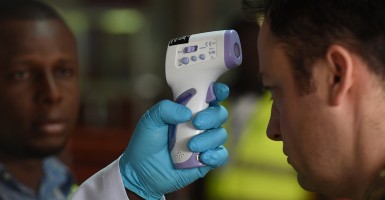As travelers prepare to board planes for the holidays, the Centers for Disease Control and Prevention continues to screen passengers flying into the U.S. for Ebola, even as the media uproar surrounding the deadly virus has faded.
Local and state health officials actively monitor about 1,700 persons for symptoms of Ebola, although the number fluctuates daily as travelers move in and out of the 21-day monitoring window.
Some have presented symptoms such as fever, but none have tested positive for Ebola, Kristen Nordlund, a spokeswoman for the CDC in Atlanta, told The Daily Signal.
The total number being monitored is not published on the agency’s website, she said.
“CDC’s continued efforts are prudent, given the continued difficulties in Africa,” Steven Bucci, a national security and foreign policy expert at The Heritage Foundation, told The Daily Signal:
Trying to achieve a balance between protecting Americans [and] not causing problems for travel in general is very tough. CDC seems to be getting it right.
Travelers entering the U.S. from West African countries continue to come through five airports: Washington Dulles International, Chicago O’Hare, John F. Kennedy in New York, Hartsfield-Jackson Atlanta and Newark Liberty.
Officials with Customs and Border Protection first isolate travelers coming from West African countries affected by the virus — Guinea, Sierra Leone, Liberia and Mali — and conduct a screening that includes a questionnaire and contact form. Individuals also have their temperatures taken.
Eight passengers were taken to medical facilities for additional screening, according to data compiled by the Department of Homeland Security. In most cases where symptoms of Ebola are present, Nordlund said, patients may test positive for the flu or malaria instead.
>>> Ebola Czar to Leave White House in February
The CDC issued guidelines for state and local public health officials who are monitoring travelers from West Africa. Levels of such monitoring depends on a person’s symptoms and exposure to the disease.
For example, a health worker who treated Ebola patients in West Africa and wore personal protective equipment would be freer to move around than a worker who did not.
However, once individuals leave the airport, it becomes the responsibility of state and local officials at their destination to continue to monitor them.
“All active monitoring — calling and following-up with in-person visits — happens at the state and local level,” Nordlund said.
More than 7,300 have died from Ebola worldwide, and more than 19,000 cases were detected.
The first cases in U.S. citizens arose in late August, after two missionaries tested positive and were transported back to the U.S. to be treated. Both recovered.
On Sept. 30, a Liberian named Thomas Eric Duncan became the first person to test positive for Ebola in the U.S. He went to a Dallas hospital after presenting symptoms but was sent home. Duncan returned several days later and was admitted. He later died.
Dr. Martin Salia, an American, contracted Ebola in Sierra Leone and returned for treatment in Omaha, Neb. He, too, died, becoming the second victim to be claimed by the virus in the U.S.
A total of 10 persons tested positive for Ebola in the U.S.; Salia’s case, identified in November, was the latest.
>>> BioShield: Obama Diverted Funds from Its Fight Against Ebola, Other Threats
Since then, media coverage of the Ebola outbreak has quieted down, as Sharyl Attkisson, senior independent contributor to The Daily Signal, noted in an interview Sunday.
The investigative reporter said infectious disease experts still worry about Ebola and the possibility of it spreading to the United States. Attkisson said the CDC told her earlier this month that the number of monitored persons was 1,400; the reason for the discrepancy of 300 isn’t clear, although it could be normal fluctuation given the 21-day window.
Attkisson contended the media shouldn’t “hype” the virus but should cover Ebola despite official efforts to limit the availability of information about it:
Someone decided, I think, ‘When we give information, they cover it. If we don’t give information, it will fall off the stage.’ And it largely did. … I think there’s an effort to control the information and tamp it down.
































